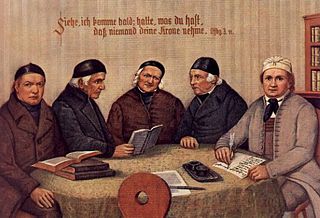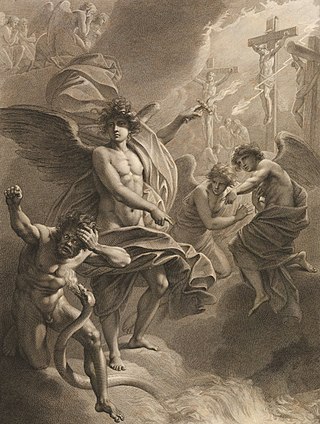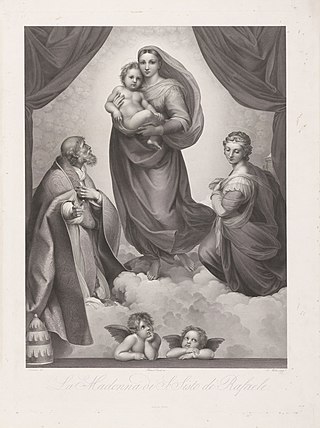
Johann Friedrich Steinkopf (5 March 1737, Oppenheim - 30 January 1825, Stuttgart) was a German landscape, animal and porcelain painter.

Johann Friedrich Steinkopf (5 March 1737, Oppenheim - 30 January 1825, Stuttgart) was a German landscape, animal and porcelain painter.
He was born to Carl Otto Steinkopf (1713-1779), a Master butcher, and his wife, Anna Elisabeth, née Finkenauer (died 1773), the daughter of a city attorney. [1] At the age of fourteen, after completing his primary education, his father sent him to work at a grocery store in Mannheim, despite his expressed interest in studying classical art. The following year, one of his cousins fell ill, so he took his place; caring for over forty post horses. [2]
In 1755, he went to work at a porcelain factory, newly established by Paul Hannong in Frankenthal, and soon became a skilled porcelain painter. In 1759, dissatisfaction with the way he was being treated prompted him to take a position at the porcelain factory in Ludwigsburg, which had been founded in 1758 under the direction of Charles Eugene, Duke of Württemberg. Numerous pieces from that period have been ascribed to him; mostly with equestrian battles and hunting scenes.
In 1770, he married Katharina Barbara Betulius (1754–1816), daughter of the publisher and bookbinder, Johann Christoph Betulius (1728–1791). The marriage produced fourteen children, including Johann Friedrich, who took over the publishing business, Carl Friedrich Adolf , an evangelical pastor, and Gottlob Friedrich, who also became a landscape painter. Eventually, his pay at the factory could not keep pace with his family's growth, so he returned to Stuttgart in 1775. [2]
There, he supported his family by giving private drawing lessons and making copies of oil paintings by popular artists of Dutch origin; primarily Philips Wouwerman and Johann Heinrich Roos, both known for their scenes featuring animals. In 1786, he was offered a position as a drawing teacher at the Stuttgart gymnasium, which he accepted and held until his retirement in 1817. Duke, later King Frederick I of Württemberg, named him a court painter, in charge of animal painting, in 1801. [2]
He died just over a month short of his 88th birthday. In his later life, he had amassed a large collection of drawings, engravings and paintings that were auctioned off a few months later. The sales catalog came to eighty pages. [1]


Carl Gustav Carus was a German physiologist and painter, born in Leipzig, who played various roles during the Romantic era. A friend of the writer Johann Wolfgang Goethe, he was a many-sided man: a doctor, a naturalist, a scientist, a psychologist, and a landscape painter who studied under Caspar David Friedrich.

Elias Gottlob Haussmann was a German painter in the late Baroque era. Haussmann served as court painter at Dresden, and from 1720, as the official portraitist at Leipzig. He is mostly known for his portrait of Johann Sebastian Bach which was painted in 1746.

Carl Wilhelm Friedrich Oesterley was a German painter and art historian. He is remembered largely for creating oil paintings with Biblical themes.

Caspar David Friedrich in his Studio refers to two paintings by the German romantic artist Georg Friedrich Kersting dated 1811 and 1819. Of these the 1819 version, now in the Alte Nationalgalerie in Berlin, is the best known. In both Kersting depicted fellow German painter Caspar David Friedrich in his studio.

Bernhard Studer was a Swiss landscape painter.

Karl Oenike (1862–1924) was a German landscape painter, who participated in various scientific expeditions in South America during the years 1887-1891 as painter and photographer. He wrote detailed diaries and made drawings, sketches, watercolors, oil paintings and photos during these expeditions, which give a valuable perspective of remote regions and populations, and of the difficulties encountered by German explorers in the 1880s. Few artists in the exotic art genre have depicted better the “magic of the forest” in his paintings.

Michael Hahn was a German Pietist, Theosophist and the founder of the Hahn'schen Gemeinschaft. His alleged forename Johann does not appear on his birth certificate.

Louis Mayer, born Ludwig Hartmann Mayer, was a German landscape painter and brother to the poet Karl Mayer.

The State Academy of Fine Arts Stuttgart is a public fine art university in Stuttgart, Germany. It was founded in 1761 and has been located on the Weissenhof since 1946. Its campus consists of three buildings: the Altbau, Neubau 1 or "Architects' Building", and Neubau 2.

Gottlob Friedrich Steinkopf was a German landscape painter in the Classical style.

Christiane Luise Duttenhofer was a German papercutting artist. She was raised in a middle class Protestant family, who gave her some art education but did not permit her to become a professional artist. At the age of 28, she married her cousin, the engraver Christian Duttenhofer. Three of their seven children reached adulthood. After a voyage to Rome around 1805, where they met several German artists and experienced classical antiquity, the couple moved to Stuttgart. There, Duttenhofer was in contact with the educated bourgeoisie and also met famous authors like Jean Paul and Johann Wolfgang von Goethe.

Friedrich Schaarschmidt was a German landscape painter and figure painter of the Düsseldorf school of painting, conservator and art writer.

Carl Ebert was a German landscape painter.
Johann Friedrich Steinkopf was a German bookseller and publisher.

Johann Friedrich Leybold was a German miniaturist painter and copper engraver.

Karl Jakob Theodor Leybold was a German painter, engraver and lithographer.

Johann Friedrich Dieterich was a German painter and art professor.
Friedrich Ludwig Heinrich Waagen also Christian Friedrich Ludwig Heinrich Waagen, Wagen or Wage) was a German portrait, history and landscape painter born in the Holy Roman Empire. Hardly anything is known about his works. However, he had acquired extensive knowledge of art, amassed a collection of paintings in Hamburg and was known to friends with or in-laws of many important personalities of his time. Gustav Friedrich Waagen (1794-1868) and Carl Waagen (1800-1873) are his sons.

Margarete Oppenheim was a German art collector and patron. She was among the first personalities to collect works of modern art in Germany and owned one of the largest collection in Germany. She is also known as Margarete Oppenheim-Reichenheim.

Johann Friedrich Wilhelm Müller was a German copperplate engraver.
![]() Media related to Johann Friedrich Steinkopf at Wikimedia Commons
Media related to Johann Friedrich Steinkopf at Wikimedia Commons